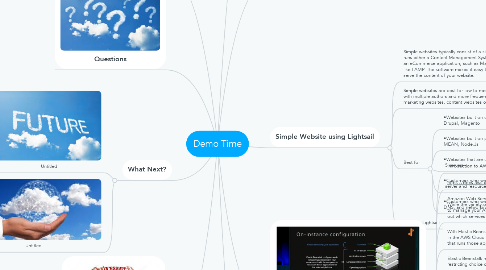
1. Precautions
1.1. AWS Charges
1.1.1. Billing
1.1.1.1. Billing Preferences
1.1.1.1.1. Enable "Receive Billing Alerts"
1.1.2. Cloud Watch
1.1.2.1. Create Billing Alarms
1.2. Don't upload our office code in any Cloud
2. What Next?
2.1. Untitled
2.2. Untitled
3. Questions
4. Untitled
5. Simple Website using EC2
6. Simple Static Website Hosting
6.1. Static websites deliver HTML, JavaScript, images, video and other files to your website visitors and contain no server-side application code, like PHP or ASP.NET. They typically are used to deliver personal or marketing sites.
6.2. Static websites are very low cost, provide high-levels of reliability, require no server administration, and scale to handle enterprise-level traffic with no additional work.
6.3. Best for
6.3.1. •Websites that change infrequently with few authors
6.3.2. •Websites need to scale for occasional intervals of high traffic
6.3.3. •Customers who do not want to manage infrastructure
6.4. S3
6.4.1. https://aws.amazon.com/getting-started/projects/host-static-website/?c_1
6.4.2. https://docs.aws.amazon.com/AmazonS3/latest/dev/website-hosting-custom-domain-walkthrough.html
6.4.3. http://d0.awsstatic.com/whitepapers/Building%20Static%20Websites%20on%20AWS.pdf
6.4.4. https://dev.to/samueldaviddelacruz/how-to-host-your-static-web-app-on-aws-s3-in-10-steps-3kgp
6.4.5. Static Website in S3 Using Certificate Manager & Cloudfront
7. Simple Website using Lightsail
7.1. Simple websites typically consist of a single web server which runs either a Content Management System (CMS), such as WordPress, an eCommerce application, such as Magento, or a development stack, like LAMP. The software makes it easy to build, update, manage, and serve the content of your website.
7.2. Simple websites are best for low to medium trafficked sites with multiple authors and more frequent content changes, such as marketing websites, content websites or blogs.
7.3. Best for
7.3.1. •Websites built on common applications like WordPress, Joomla, Drupal, Magento
7.3.2. •Websites built on popular development stacks like LAMP, LEMP, MEAN, Node.Js
7.3.3. •Websites that are unlikely to scale beyond 5 servers
7.3.4. •Customers who want to manage their own web server and resources
7.3.5. •Customers who want one console to manage their web server, DNS, and networking
7.4. Amazon Lightsail
8. Simple Website using Elastic Bean Stalk
8.1. Introduction to AWS Elastic Beanstalk
8.2. https://docs.aws.amazon.com/elasticbeanstalk/latest/dg/tutorials.html
8.3. Amazon Web Services (AWS) comprises many services in many areas. While the variety of services offers flexibility for how you want to manage your AWS infrastructure, it can be challenging to figure out which services to use and how to provision them.
8.4. With Elastic Beanstalk, you can quickly deploy and manage applications in the AWS Cloud without having to learn about the infrastructure that runs those applications
8.5. Elastic Beanstalk reduces management complexity without restricting choice or control.
8.6. AWS Resources Created
8.6.1. EC2 instance
8.6.2. Instance security group
8.6.3. Amazon S3 bucket
8.6.4. Amazon CloudWatch alarms
8.6.5. AWS CloudFormation stack
8.6.5.1. https://intellipaat.com/blog/aws-cloudformation-tutorial/
8.6.5.2. Introduction to AWS CloudFormation
8.6.6. Domain name
9. Enterprise Web Hosting
9.1. Enterprise websites include very popular marketing and media sites, as well as social, travel, and other application-heavy websites. For example, Lamborghini, Coursera, and Nordstrom use AWS to host their websites
9.2. Enterprise websites need to dynamically scale resources and be highly available to support the most demanding and highly trafficked websites.
9.3. Enterprise websites built on AWS provide high levels of availability, scalability, and performance, but require higher amounts of management and administration than static or simple websites.
9.4. Best for
9.4.1. •Websites that use multiple web servers across at least two data centers
9.4.2. •Websites that need to scale using load balancing, autoscaling, or external databases
9.4.3. •Websites that require sustained high CPU utilization
9.4.4. •Customers who need maximum control and flexibility for their web server configuration and administration
